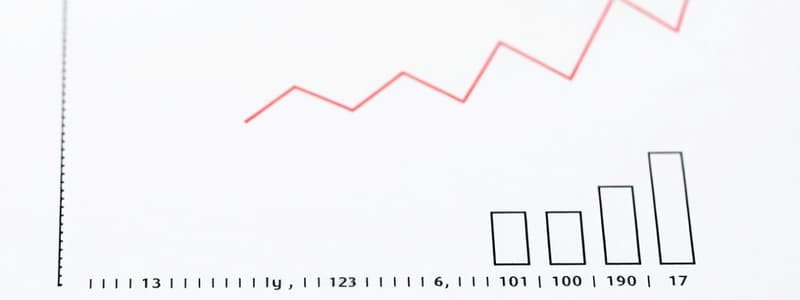Podcast
Questions and Answers
Explain the fundamental difference in focus between microeconomics and macroeconomics. How do these two branches of economics complement each other?
Explain the fundamental difference in focus between microeconomics and macroeconomics. How do these two branches of economics complement each other?
Microeconomics studies individual economic agents like households and firms, while macroeconomics examines the aggregate behavior of the entire economy, considering variables like GDP and inflation. They complement each other by providing different levels of analysis to understand economic phenomena.
What is the key distinction between the ‘slicing method’ and the ‘lumping method’ in economic analysis?
What is the key distinction between the ‘slicing method’ and the ‘lumping method’ in economic analysis?
The slicing method analyzes individual units or variables separately, while the lumping method aggregates these units into larger groups for analysis. Slicing examines individual components in detail, whereas lumping looks at the collective impact.
Differentiate between individual demand and market demand. How is market demand derived from individual demands?
Differentiate between individual demand and market demand. How is market demand derived from individual demands?
Individual demand refers to the quantity of a good or service that a single consumer is willing and able to purchase at various price levels, while market demand is the total quantity that all consumers in the market are willing and able to purchase. Market demand is derived by horizontally summing up all the individual demand curves.
Explain the difference in the effects on the demand curve between 'expansion of demand' and 'increase in demand'.
Explain the difference in the effects on the demand curve between 'expansion of demand' and 'increase in demand'.
What is the difference between GNP and GDP? How does understanding this difference help in assessing a country's economic performance?
What is the difference between GNP and GDP? How does understanding this difference help in assessing a country's economic performance?
Flashcards
Micro-Economics
Micro-Economics
Studies individual economic units, like households and firms.
Macro-Economics
Macro-Economics
Studies the economy as a whole, focusing on aggregate variables.
Individual Demand
Individual Demand
Demand of a single consumer for a specific good or service.
Market Demand
Market Demand
Signup and view all the flashcards
Expansion of Demand
Expansion of Demand
Signup and view all the flashcards
Study Notes
- The text contains a list of economic terms to distinguish between
Microeconomics and Macroeconomics
- Microeconomics focuses on individual economic agents, like households and firms
- Macroeconomics examines the economy as a whole, including factors like inflation, unemployment, and economic growth
Slicing Method and Lumping Method
- The Slicing Method involves analyzing individual components in detail
- The Lumping Method aggregates components into broader categories for analysis
Individual Demand and Market Demand
- Individual demand refers to the quantity a single consumer is willing and able to purchase at various prices
- Market demand is the total quantity demanded by all consumers in a market at various prices
Expansion and Contraction of Demand
- Expansion of demand is an increase in quantity demanded due to factors other than price
- Contraction of demand is a decrease in quantity demanded due to an increase in price
Unitary Elastic Demand and Relatively Elastic Demand
- Unitary elastic demand occurs when a percentage change in price leads to an equal percentage change in quantity demanded
- Relatively elastic demand occurs when a percentage change in price leads to a larger percentage change in quantity demanded
Stock and Supply
- Stock is the total amount of a commodity available at a specific point in time
- Supply refers to the quantity of a commodity that producers are willing to offer for sale at various prices
Individual Supply and Market Supply
- Individual supply refers to the quantity a single producer is willing and able to sell at various prices
- Market supply is the total quantity supplied by all producers in a market at various prices
Simple Index Number and Weighted Index Number
- A Simple Index Number measures the change in the price or quantity of a single item relative to a base period
- A Weighted Index Number considers the relative importance of different items when measuring overall change
Output Method and Income Method
- The Output Method calculates GDP by summing the value of all final goods and services produced in an economy
- The Income Method calculates GDP by summing all income earned in an economy, including wages, profits, and rents
GNP and GDP
- GNP (Gross National Product) measures the total income earned by a country's residents, regardless of where it was earned
- GDP (Gross Domestic Product) measures the total value of goods and services produced within a country's borders
Direct Tax and Indirect Tax
- Direct taxes are levied directly on individuals or organizations and cannot be shifted to others
- Indirect taxes are levied on goods and services and can be shifted to consumers through higher prices
Demand Deposit and Time Deposit
- Demand deposits are funds held in an account that can be withdrawn at any time without prior notice
- Time deposits are funds held in an account for a fixed period and cannot be withdrawn before maturity without penalty
Studying That Suits You
Use AI to generate personalized quizzes and flashcards to suit your learning preferences.




